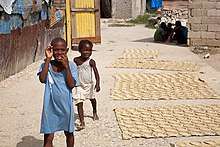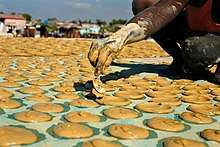Mud cookie
A mud cookie or bonbon tè in Haitian Creole is a food that is eaten in Haiti, particularly in times of starvation. They can be found in slums like Cité Soleil. Dirt is collected from the nation's central plateau, near the town of Hinche, and trucked over to the market (e.g. La Saline market) where women purchase it.[1][2][3] It is processed into cookies in shanty towns such as Fort Dimanche.[3] First, the dirt is strained to remove rocks and clumps.[3] The dirt is mixed with salt and vegetable shortening or fat.[1][4] It is formed into flat discs.[1] Then, it is dried in the sun.[4] The finished product is transported in buckets and is sold in the market or on the streets.[2]


Due to the mineral content, it was traditionally used as a dietary supplement for pregnant women and children.[1][4] For example, its calcium content could be used as an antacid and for nutrition.[4] The production cost is cheap; the dirt to make one hundred cookies was five US dollars in 2008 (about 5 cents apiece) even after increasing $1.50.[2][3] It is also seen as a way to stave off starvation.[1][4] This is especially true in times where there is a rise in global food prices like in 2008.[2][5]
The taste has been described as a smooth consistency that immediately dries the mouth with an unpleasant aftertaste of dirt that lingers for hours.[3]
The clay may also contain toxins and parasites, posing a health risk.[1][3]
See also
References
- Clammer, P. (2016). Haiti. Bradt Travel Guides (in French). Bradt Travel Guides. p. 71. ISBN 978-1-84162-923-0. Retrieved 2019-12-21.
- Agamben, G.; Badiou, A.; Bensaid, D.; Brown, W.; Nancy, J.L.; Rancière, J.; Ross, K.; Žižek, S.; McCuaig, W. (2011). Democracy in What State?. New Directions in Critical Theory. Columbia University Press. p. 109. ISBN 978-0-231-52708-8. Retrieved 2019-12-21.
- "Poor Haitians on a mud diet". Los Angeles Times. 2008-02-03. Retrieved 2019-12-21.
- Nevins, D. (2015). Haiti: Third Edition. Cultures of the World (Third Edition) ®. Cavendish Square. p. 123. ISBN 978-1-5026-0802-4. Retrieved 2019-12-21.
- Feeding Frenzy: Land Grabs, Price Spikes, and the World Food Crisis. Greystone Books. 2014. p. 47. ISBN 978-1-77164-014-5. Retrieved 2019-12-21.
| Wikimedia Commons has media related to Mud cookies. |